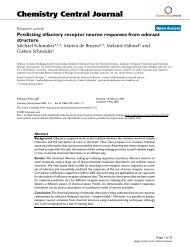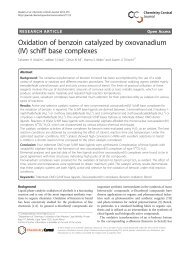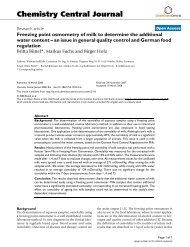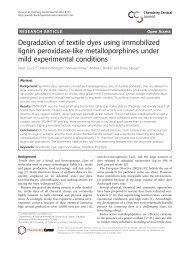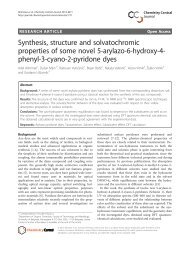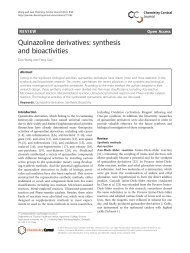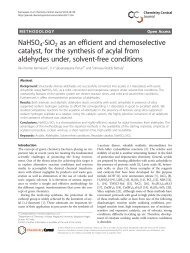Development and validation of stability indicating method for ...
Development and validation of stability indicating method for ...
Development and validation of stability indicating method for ...
Create successful ePaper yourself
Turn your PDF publications into a flip-book with our unique Google optimized e-Paper software.
Walash et al. Chemistry Central Journal 2011, 5:61<br />
http://journal.chemistrycentral.com/content/5/1/61<br />
Page 2 <strong>of</strong> 11<br />
product <strong>of</strong> Global Napi Pharmaceuticals <strong>for</strong> REXCEL<br />
EGYPT.<br />
▪ Lustral ® tablets, batch # 9201, labeled to contain<br />
50.0 mg <strong>of</strong> SER/tablet, product <strong>of</strong> Pfizer Egypt S.A.E.<br />
Cairo.<br />
Figure 1 Structural <strong>for</strong>mula <strong>of</strong> SER.<br />
determination <strong>of</strong> drug in plasma nor with the <strong>stability</strong><br />
study <strong>of</strong> the drug. Since the purpose <strong>of</strong> <strong>stability</strong> studies<br />
is to monitor possible changes to a product or a material<br />
over a time at different storage conditions, it is<br />
expected that, only those <strong>method</strong>s that are <strong>stability</strong><strong>indicating</strong><br />
should be used.<br />
The parent drug <strong>stability</strong> guidelines issued by the<br />
international conference <strong>of</strong> harmonization (ICH) [22]<br />
requires that analytical test procedure should indicate<br />
<strong>stability</strong>. There<strong>for</strong>e, the present study was extended to<br />
establish the inherent <strong>stability</strong> <strong>of</strong> SER under different<br />
stress conditions such as, alkaline, acidic, oxidative <strong>and</strong><br />
photolytic conditions.<br />
Experimental<br />
Apparatus<br />
Spectrophotometric analysis was carried out on a Shimadzu<br />
(Kyoto, Japan) UV-1601 PC, UV-Visible doublebeam<br />
spectrophotometer with matched 1 cm path-length<br />
quartz cells. Absorption spectra were recorded on a fast<br />
scan speed, setting slit width to be 1 nm <strong>and</strong> sampling<br />
interval to be auto.<br />
The spectr<strong>of</strong>luorimetric measurements were made<br />
using Perkin Elmer LS 45 Luminescence Spectrometer<br />
equippedwith150WattXenonarclamp<strong>and</strong>quartz<br />
cell (1 cm).<br />
Materials <strong>and</strong> Reagents<br />
All reagents <strong>and</strong> solvents were <strong>of</strong> Analytical Reagent<br />
grade.<br />
- The pure sample <strong>of</strong> sertraline (SER) was kindly supplied<br />
by the Egyptian Company <strong>for</strong> Chemicals <strong>and</strong> Pharmaceuticals<br />
(ADWIA) (10 th <strong>of</strong> Ramadan City, Egypt), with<br />
a purity <strong>of</strong> 99.78% as determined by the reference <strong>method</strong><br />
[23]. The following preparations containing the drug were<br />
purchased from local pharmacies:<br />
▪ Seserine ® tablets, batch # 080371, labeled to contain<br />
56.0 mg SER HCl equivalent to 50.0 mg SER/<br />
tablet, product <strong>of</strong> ADWIA Co. S.A.E, 10 th <strong>of</strong> Ramadan<br />
City, Egypt.<br />
▪ Serlift ® tablets, batch # 810102, labeled to contain<br />
SER HCl equivalent to 100.0 mg SER/tablet,<br />
- Plasma was kindly provided by Mansoura University<br />
Hospital, <strong>and</strong> kept frozen until use after gentle thawing.<br />
- 4-Chloro-7-nitrobenzo-2-oxa-1,3-diazole (NBD-Cl )<br />
purchased from Sigma ( St.Louis USA). A stock solution<br />
containing 0.2% (w/v) <strong>of</strong> the reagent was freshly prepared<br />
in methanol.<br />
-Methanol, hydrochloric acid <strong>and</strong> diethyl ether<br />
(Merck, Darmstadt, Germany).<br />
- Borate buffer (0.2 M, pH 7.8), phosphate buffer<br />
(0.2M, pH 12).<br />
- 1.0 M aqueous solution <strong>of</strong> sodium hydroxide (BDH,<br />
UK).Hydrogen peroxide (BDH, UK); 0.1% (v/v) aqueous<br />
solution<br />
St<strong>and</strong>ard solution<br />
A stock solution was prepared by dissolving 20.0 mg <strong>of</strong><br />
SER in 100 mL <strong>of</strong> methanol <strong>and</strong> was further diluted with<br />
the same solvent as appropriate. The st<strong>and</strong>ard solutions<br />
were stable <strong>for</strong> seven days when kept in the refrigerator.<br />
General Procedure<br />
Construction <strong>of</strong> the Calibration Curve<br />
a) Spectrophotometric <strong>method</strong> (Method I) To a set <strong>of</strong><br />
10 mL volumetric flasks, aliquot volumes containing the<br />
drug were quantitatively transferred to obtain final concentrations<br />
<strong>of</strong> 2-24 μg/mL <strong>of</strong> SER. 2.0 mL <strong>of</strong> borate buffer<br />
(pH 7.8) followed by 1 mL <strong>of</strong> NBD-Cl solution (0.2% w/v)<br />
<strong>and</strong> were mixed well. The solutions were heated in a thermostatically<br />
controlled water bath at 60°C <strong>for</strong> 25 min. The<br />
reaction was stopped by cooling under tap water, <strong>and</strong> then<br />
0.2 mL <strong>of</strong> concentrated HCl was added. The solutions<br />
were quantitatively transferred to 10 mL volumetric flasks<br />
<strong>and</strong>eachflaskwasmadeuptovolumewithmethanol.<br />
The absorbance was measured at 395 nm against a reagent<br />
blank. The calibration graph was constructed by plotting<br />
the absorbance versus the final concentration <strong>of</strong> the drug<br />
(μg/mL). Alternatively, the corresponding regression equation<br />
was derived.<br />
b) Spectr<strong>of</strong>luorimetric <strong>method</strong> (Method II) The procedure<br />
adopted <strong>for</strong> spectrophotometric <strong>method</strong> was per<strong>for</strong>med<br />
after dilution <strong>of</strong> the st<strong>and</strong>ard solution to obtain<br />
the working concentration range <strong>of</strong> 0.25-5 μg/mL. The<br />
fluorescence intensity <strong>of</strong> the resulting solutions was<br />
measured at 530 nm after excitation at 480 nm. The<br />
corrected fluorescence intensity (ΔF) was plotted vs the<br />
final concentrations <strong>of</strong> the drug (μg/mL) to get the calibration<br />
curve. Alternatively, the regression equation was<br />
derived.





